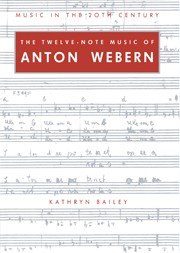Book contents
- Frontmatter
- Contents
- Acknowledgements
- Conventions in the text
- Introduction
- PART I Row and canon
- PART II The instrumental music
- Introduction to Part II
- 4 The movements in sonata form: Opp. 20/ii, 21/i, 22/i, 24/i and 27/i
- 5 The movements in variation form: Opp. 21/ii, 24/iii, 27/iii, 28/i and 30
- 6 The movements in rondo and ternary forms: Opp. 20/i, 22/ii, 24/ii, 28/ii and 28/iii
- 7 The movement in binary form: Op. 27/ii
- PART III The music with voices
- Conclusion
- Appendices
- Notes
- Glossary
- Chronological worklist
- Select bibliography
- Index
7 - The movement in binary form: Op. 27/ii
Published online by Cambridge University Press: 23 December 2009
- Frontmatter
- Contents
- Acknowledgements
- Conventions in the text
- Introduction
- PART I Row and canon
- PART II The instrumental music
- Introduction to Part II
- 4 The movements in sonata form: Opp. 20/ii, 21/i, 22/i, 24/i and 27/i
- 5 The movements in variation form: Opp. 21/ii, 24/iii, 27/iii, 28/i and 30
- 6 The movements in rondo and ternary forms: Opp. 20/i, 22/ii, 24/ii, 28/ii and 28/iii
- 7 The movement in binary form: Op. 27/ii
- PART III The music with voices
- Conclusion
- Appendices
- Notes
- Glossary
- Chronological worklist
- Select bibliography
- Index
Summary
The second movement of the Op. 27 Variations stands alone as the only movement in binary form in all of Webern's twelve–note music. In view of Webern's description of the entire work as ‘a kind of suite’, and his likening it to the Badinerie of Bach's B minor Suite, a binary structure is particularly fitting here. The movement is a mirror canon; this fact and its row structure have been discussed elsewhere. The repeats divide it into two equal sections of eleven bars, each containing two rows and their inverted imitations. These two sections are defined by the appearance of identical two–note figures (b♭2–g#) at the beginning, at the centre and at the end of the movement, accentuating its balanced proportions. This symmetrical simple binary structure evokes baroque associations rather than the Beethovenian ones that Webern so often alludes to in describing his own work. Indeed, the very idea of a suite suggests the eighteenth rather than the nineteenth century.
The only note values used are quavers and crotchets; with five exceptions, progress is through pairs of quavers either preceded or followed by rests of the same value, creating a perceived 3/8 metre that seems to supersede the written 2/4, and that, to pursue the baroque connection, calls to mind several dance types of that period. The metrical regularity is interrupted by 2/8 units in bars 10, 12, 15, 16 and 19–20.
The texture of this movement is pointillistic and spare.
- Type
- Chapter
- Information
- The Twelve-Note Music of Anton WebernOld Forms in a New Language, pp. 262 - 264Publisher: Cambridge University PressPrint publication year: 1991

